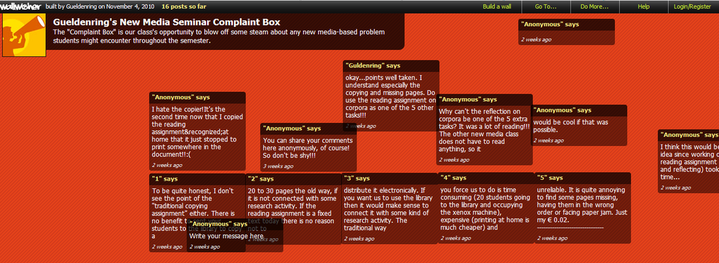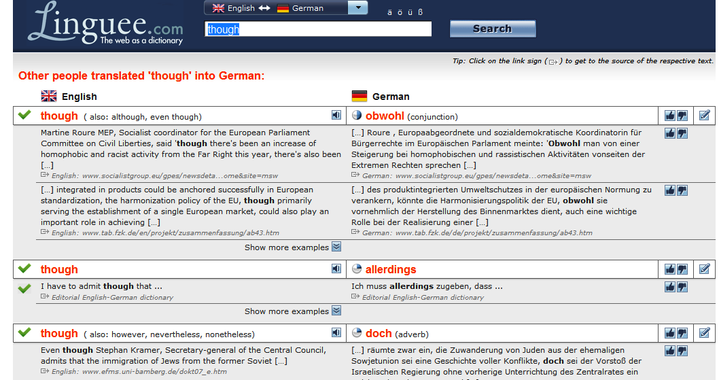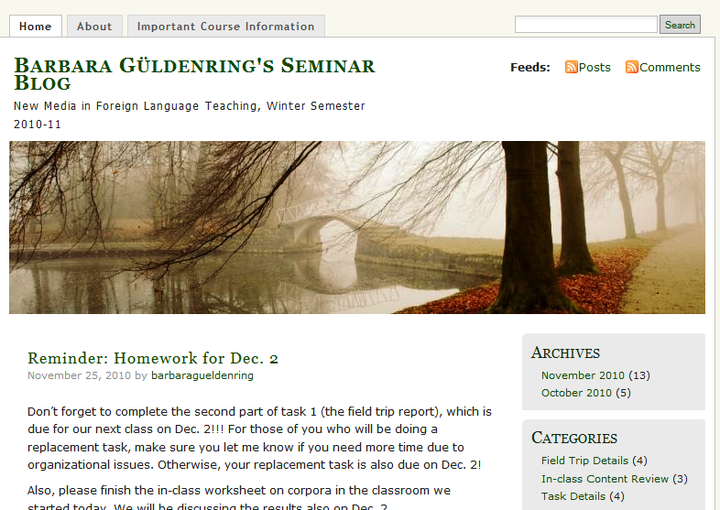Wallwisher
Wallwisher is “an online notice board marker” which means it functions like a pinboard where students can add general remarks or notes on a certain topic. The notes look like post-its and the color of the wall can be chosen as well. It can be used anonymously (just don’t type in your name then) which is good if the tool is used for complaints, as we do it in our seminar, too. It is quite good for that usage as you don’t see the students handwriting and as other students can comment on anything that was posted. The teacher gets feedback and can talk about it in class and/or change a few things in the future.
I personally like the idea of Wallwisher and the idea of using it as a “complaint box”. It is a completely anonymous method which is quite difficult to realize at school without this tool. As long as the comments are constructive it is fine. The teacher can delete comments he thinks are not appropriate or tend to hurt other students verbally (the teacher can also choose to approve every post before it shows up on the wall).
Access under: www.wallwisher.com
added: November 26, 2010
I personally like the idea of Wallwisher and the idea of using it as a “complaint box”. It is a completely anonymous method which is quite difficult to realize at school without this tool. As long as the comments are constructive it is fine. The teacher can delete comments he thinks are not appropriate or tend to hurt other students verbally (the teacher can also choose to approve every post before it shows up on the wall).
Access under: www.wallwisher.com
added: November 26, 2010
Corpora
A detailed reflection on Corpora can be found here.
Linguee
Linguee (www.linguee.com) is an online dictionary and therefore not really a totally new tool. My academic writing teacher recommended this dictionary and I decided to present it here because I think it is one of the few online dictionaries you can rely on. I used to use leo.org and dict.cc and they are not nearly as good as Linguee. Linguee works as any other dictionary, you just type in an English word (or even phrase), if you want to translate from German into English that is fine, too, and then you get the possible translations. The main difference is though that Linguee very exactly differentiates between the different meanings of a word and gives useful examples which provide content as well. It could also be said to be a kind of corpus as they give authentic examples of when a word was used and provide the address of the homepage where the example has been taken from. This makes the translator more reliable and efficient and students get a feeling for the fact that one word can be translated differently, depending on the content.
Youtube
On Youtube (everyone should know that tool, that is why I won't explain it in more detail) people can upload and download, watch and listen to various kinds of videos with different topics. Most of the videos provide authentic language, because they are created by native speakers or native speakers are the main figure in the video. This is an important aspect regarding the use of YouTube in an English classroom. Students are familiar with YouTube anyway and working with it almost daily. Many students use YouTube in order to listen to music.
There are various kinds of how teachers could include YouTube into the English classroom. One example could be the comparison of one English song and its two different videos/realizations which is one of my extra tasks. Have a look here if you are interested. The task gives you an example of how you could use YouTube in class.
There are also negative aspects but they rather concern the technical issues (Good internet connection? Sound quality good? Are certain videos blocked?...). Nevertheless, problems may occur regarding the language (slang? pronunciation?). But keep in mind that this can also be an interesting challenge for the students and this is English in real usage. Students always long for an answer to the question " Why do I have to learn that and do this?", and if you provide them with authentic material, even better with the help of a tool they use everyday, it can be very motivating.
A rather negative aspect or tendency that came up during the last years or rather months is the fact that the access to "original" videos (e.g. music) has been limited due to legal reasons. You have a more limited access but nevertheless, if you research beforehand, you can make use of YouTube music videos nevertheless. But as I said, many videos are not available which reduces the general use of YouTube enormously.
I found an interesting website on about.com which deals with YouTube in the ESL-classroom. It provides good information about why YouTube is useful and gives good hints about how you could use it and what you could do exactly. Click here.
Apart from music, you can also use YouTube for other interesting topics. Below, you find two videos which could be integrated into class when talking about Politics of the United States/ Obama/ History...!
The only thing I can add is: Make the best out of the authentic sources you can get! The possibilities are amazing compared to what students had in former times - boring texts without any motivational and "real" aspect. Use supportive new media tools.
There are various kinds of how teachers could include YouTube into the English classroom. One example could be the comparison of one English song and its two different videos/realizations which is one of my extra tasks. Have a look here if you are interested. The task gives you an example of how you could use YouTube in class.
There are also negative aspects but they rather concern the technical issues (Good internet connection? Sound quality good? Are certain videos blocked?...). Nevertheless, problems may occur regarding the language (slang? pronunciation?). But keep in mind that this can also be an interesting challenge for the students and this is English in real usage. Students always long for an answer to the question " Why do I have to learn that and do this?", and if you provide them with authentic material, even better with the help of a tool they use everyday, it can be very motivating.
A rather negative aspect or tendency that came up during the last years or rather months is the fact that the access to "original" videos (e.g. music) has been limited due to legal reasons. You have a more limited access but nevertheless, if you research beforehand, you can make use of YouTube music videos nevertheless. But as I said, many videos are not available which reduces the general use of YouTube enormously.
I found an interesting website on about.com which deals with YouTube in the ESL-classroom. It provides good information about why YouTube is useful and gives good hints about how you could use it and what you could do exactly. Click here.
Apart from music, you can also use YouTube for other interesting topics. Below, you find two videos which could be integrated into class when talking about Politics of the United States/ Obama/ History...!
The only thing I can add is: Make the best out of the authentic sources you can get! The possibilities are amazing compared to what students had in former times - boring texts without any motivational and "real" aspect. Use supportive new media tools.
Blogs (e.g.Wordpress)
I have to admit that I did not know the idea of a blog before my studies. (Honestly, I got to know the word in Grammar One when I had to think about how the word came into existence!!) I have never had an own blog, I just worked with Weebly (which includes a blog, but which is not the same). The idea of using a blog, in our case Wordpress, for the seminar and its weekly updates is very good. It is always up-to-date (at least as long as the teacher updates it regularly) and you can look at it whenever you have time. I personally believe it is important that the blog is not overloaded with information and material. It should always be structured clearly and focused on the important issues that have to be made clear. This is also very important for school as you can easily confuse your students with too much stuff on it. Be precise and be well structured. The instructions should be clear. I really like the idea of a blog, and Wordpress is an easy alternative to create one. It functions like Weebly, you have to sign up at first before you can start creating your blog.
The tool is not only useful for the teacher who can provide an up-to-date reference of the class and what is to do for the next session but it could also be used by the students in order to establish a learning diary or a portfolio. The good thing is that they can not only include textual information but they can also play around and include other things they find interesting. I think that this tool is especially good for the Oberstufe, but you could also use it in lower forms.
The tool is not only useful for the teacher who can provide an up-to-date reference of the class and what is to do for the next session but it could also be used by the students in order to establish a learning diary or a portfolio. The good thing is that they can not only include textual information but they can also play around and include other things they find interesting. I think that this tool is especially good for the Oberstufe, but you could also use it in lower forms.
Weebly
For further information about how to easily create a webpage as a teacher or student, look at the chapter "Five Plus".
My Closing Words
If I think about the world we are living in today, in the 21st century, I come to the conclusion that we have to educate the students we have nowadays, not the student we used to have in former times. We must include their world of today's 21st century technology into our schools. Our world is constantly changing and our schools have to go along at the same pace. Teachers really have to change their ways of teaching in order to be able to do it and schools have to be provided with enough money in order to being able to implement new media at school. I think that it will still take a couple of years until our schools are converted into modern schools that are adapted to the changes, challenges and innovations of the new millennium. Our students and even we ourselves are the first networked generation!
But Stadtfeld points out, and I agree with him, that the methodical and didactical adaption is important as well. I think that due to our world changing so fast nowadays, faster than ever before, people are kind of overtrained sometimes regarding their personal "update" on the innovations (especially teachers). Teachers really have to have knowledge about the tools in order to use them at school. Additionally, we live in a fast-moving world. Who knows what and how we will teach in 50 years? Maybe our new media will be old already, maybe students excusively work with what we call new media today. Who knows?
Obviously, we have to use new media in school and I am very positively surprised about what you can do with new media (I did not know that before), but always keep in mind that you have to keep it interesting and diversified. Once students get used to a tool they use too often, they will get bored. Always be aware of the dangers. Use the new media respectfully and wisely and don't completely exclude the traditional methods of teaching! That is my opinion and that is why I am convinced that finding the balance between old and new is the key to seccess :-). As Stadtfeld correctly points out, teachers often use various forms of teaching in the classroom and it is not proved yet whether new media have a positive influence on the learning process or not, because the development is still too young.
added: November 27, 2010
But Stadtfeld points out, and I agree with him, that the methodical and didactical adaption is important as well. I think that due to our world changing so fast nowadays, faster than ever before, people are kind of overtrained sometimes regarding their personal "update" on the innovations (especially teachers). Teachers really have to have knowledge about the tools in order to use them at school. Additionally, we live in a fast-moving world. Who knows what and how we will teach in 50 years? Maybe our new media will be old already, maybe students excusively work with what we call new media today. Who knows?
Obviously, we have to use new media in school and I am very positively surprised about what you can do with new media (I did not know that before), but always keep in mind that you have to keep it interesting and diversified. Once students get used to a tool they use too often, they will get bored. Always be aware of the dangers. Use the new media respectfully and wisely and don't completely exclude the traditional methods of teaching! That is my opinion and that is why I am convinced that finding the balance between old and new is the key to seccess :-). As Stadtfeld correctly points out, teachers often use various forms of teaching in the classroom and it is not proved yet whether new media have a positive influence on the learning process or not, because the development is still too young.
added: November 27, 2010
Source picture: http://www.philipp-lischke.de/index.php?seite=uebermich&submenue=steckbrief (access: December 05, 2010)




